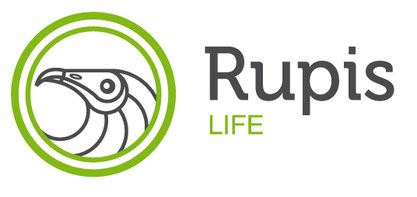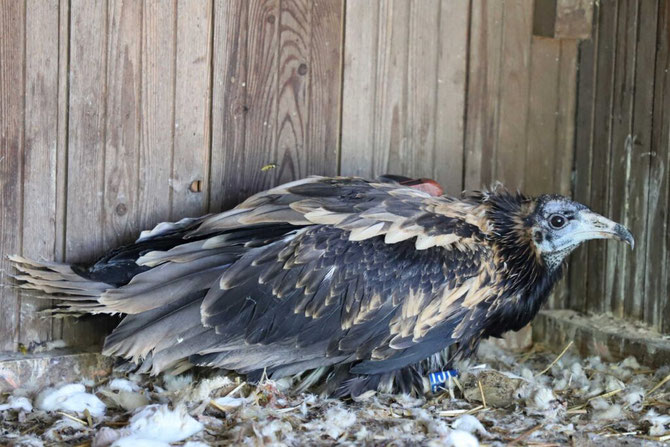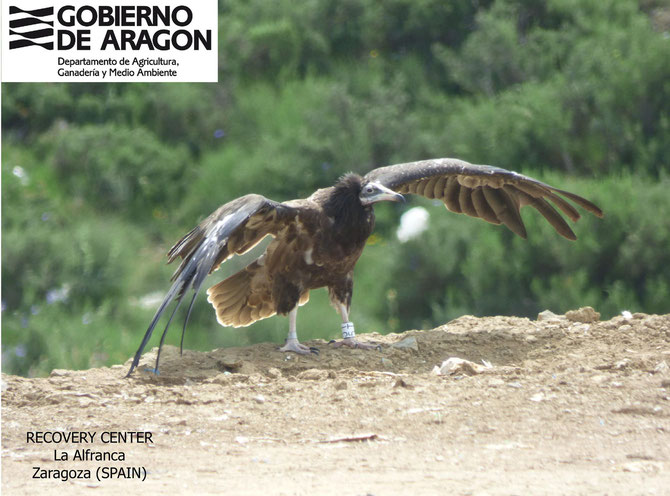
On this World Migratory Bird Day, we will take a closer look into the migratory journeys of Egyptian Vultures originating from different regions and countries, and of different backgrounds — some are captive-bred, some wild-hatched and others spent their first years in rehabilitation.
Egyptian Vulture migration
Every year, during the end of summer and start of autumn, adult and young birds leave their breeding and hatching places, to embark on their long migration journey travelling from Europe to Africa. Young birds then usually stay in Africa for at least 18 months (sometimes longer) before returning to their natal origins in Europe in the spring, and starting their annual cycle of migration to Africa in the autumn and back to Europe in the spring. After five or six years they reach sexual maturity and try to establish their own territory and form a breeding pair, often not far from where they hatched themselves. Although most Egyptian Vultures in Europe migrate, there are a few exceptions – some birds stay in Europe all year round. For example, the resident Menorca population, some individuals regularly wintering in Extremadura, and elsewhere, like the Italian Egyptian Vulture Diego that remained in Italy last year instead of migrating.

We here at the Vulture Conservation Foundation follow the movements of several Egyptian Vultures, some are wild-hatched, originating from the Douro Valley region of Portugal and Spain, and France, while others are captive-bred and released in Italy. Several of our Egyptian Vultures equipped with GPS tags already crossed to Africa — some already reached their wintering grounds but others still have some way to go until they finish their autumn migration.
LIFE Rupis Egyptian Vulture
As part of the LIFE Rupis project in the Douro, several wild Egyptian Vultures were equipped with GPS tags to follow their movements, identify threats and help implement targeted conservation actions.
Faia is a female Egyptian Vulture that was captured at the Escalhão supplementary feeding site in June 2017, and since then, we’ve been tracking her autumn and spring migration every year. This year, on Friday, 21 August, Faia signalled the start of her migration as she left the Douro and started heading south. Then, on Monday, 24 August, she successfully crossed the Strait of Gibraltar and was making her way south through Morocco. Just like every year, we lost track of Faia when she left entered Algeria a couple of weeks ago. GSM coverage is fragmented in the desert, and the experience that we have with the birds tagged in LIFE Rupis is that we often are without notice of them for some days, weeks or even months. We might not receive signals from Faia until next spring — we hope that all goes well and manages to return to the Douro next year to breed again!
Arribas is another LIFE Rupis tagged bird, this time a juvenile that was marked as a chick in the nest last year in the Douro canyon. The vulture has migrated to Africa last year and remains there for the time being. Interestingly, it recently crossed paths with another young Egyptian Vulture that we tagged, but the other vulture originates from Italy!

Fangueiro, the male Egyptian Vulture found weak and with problematic feathers, spent almost a year in recovery, with lots of operations and treatments such as imping where he got new feathers to be able to return to the wild. He was released this spring and just started its journey south and might cross to Africa any day now. Or will he stay and winter in Spain?


Italian Egyptian Vultures
As part of a release programme led by the CERM Endangered Raptors Centre (Italy), in collaboration with us here at the Vulture Conservation Foundation (VCF), the Egyptian Vulture Captive Breeding Network (EEP), and now the LIFE Egyptian Vulture Project, captive-bred Egyptian Vultures are released in Italy through different methods to restock the vulnerable local population. Ahead of the releases, Egyptian Vultures are fitted with GPS tags to follow their progress and movements, and we provide some of the tags.
Jane, the vulture that recently used the same areas like Arribas in southern Mauritania, is one of the captive-bred birds released as part of these restocking efforts. Jane hatched in 2018 at the CERM and was released in 2019 in the framework of the LIFE Egyptian vulture project by CERM and ISPRA. She migrated to Africa last autumn, where she will most likely stay for 2 to 3 years. It is interesting to see that Jane is wandering a lot in the wintering grounds as she has so far spent some time in Niger, Nigeria, Burkina-Faso, Mali and Mauritania in contrast with for example Sara and Tobia who were released in 2015 and stayed in the more eastern area for during the time they spent in Africa.
Sara is another captive-bred vulture from this project that hatched at CERM in 2015 and was released in the same year. She migrated to Africa in autumn of 2015 and remained there until 2019 when she came back to Italy during spring. She carried out another round trip from summer 2019 to spring 2020, and left again for Africa this autumn! Sara used almost the same way to fly north and south – and only in Algeria – she sometimes uses a path more in the west or east. This might depend on the actual winds during migration. We do hope that Sara will return to the breeding grounds next spring and as she reached maturity start to breed.

Birba and Clint hatched in captivity at CERM in 2020 and were released this August. Both of these young birds chose a straight path towards Africa during their first migratory journey. From mainland Italy, they crossed the Strait of Messina and arrived to Sicily where they spent some days. They then travelled to the island of Pantelleria, spent one night, and the following day crossed over the sea again, reaching Tunisia. The last GPS data from Clint is from Mali and Birba’s last location is still from Algeria. We hope that soon more data arrives and we know that they made it to the wintering grounds safely.


The Egyptian Vulture Buoux hatched in 2018 in Baronnies, where Vautours en Baronnies equipped him with a ring in the nest. Just one week after leaving the nest, LPO PACA rescued the injured vulture who had to spend some time in recovery at Centre régional de sauvegarde de la faune sauvage. A few months later, in spring 2019 he was released back to the wild and was equipped with a GPS tag provided by us. Just two months after the first rescue and release of Buoux, we realised that something was wrong with the bird thanks to the GPS data. The last known location of Buoux was around Huesca in Aragon, so we informed our colleagues from Gobierno de Aragon about the situation who immediately went to the field and rescued the bird in time. Buoux entered the Egines Recovery Centre where they determined that he broke its wing due to a collision with a power line. He had to spend almost a year in rehabilitation until he made a full recovery, and in the beginning of May 2020, he was released back to the wild. At his 3 CY, after spending the majority of his first years in captivity, being rescued and rehabilitated twice, Buoux managed to successfully cross the Strait of Gibraltar, one of the most difficult parts of the species’ long migration journey. He reached Morocco and continued heading south, making good progress and reaching Mauritania, being relatively “close” to Jane and Arribas.
We will keep monitoring the movements of these Egyptian Vultures and keep you informed. We these birds will return back to Europe when they are ready to breed!
Stay tuned with Europe’s vulture by signing up to our newsletter!









